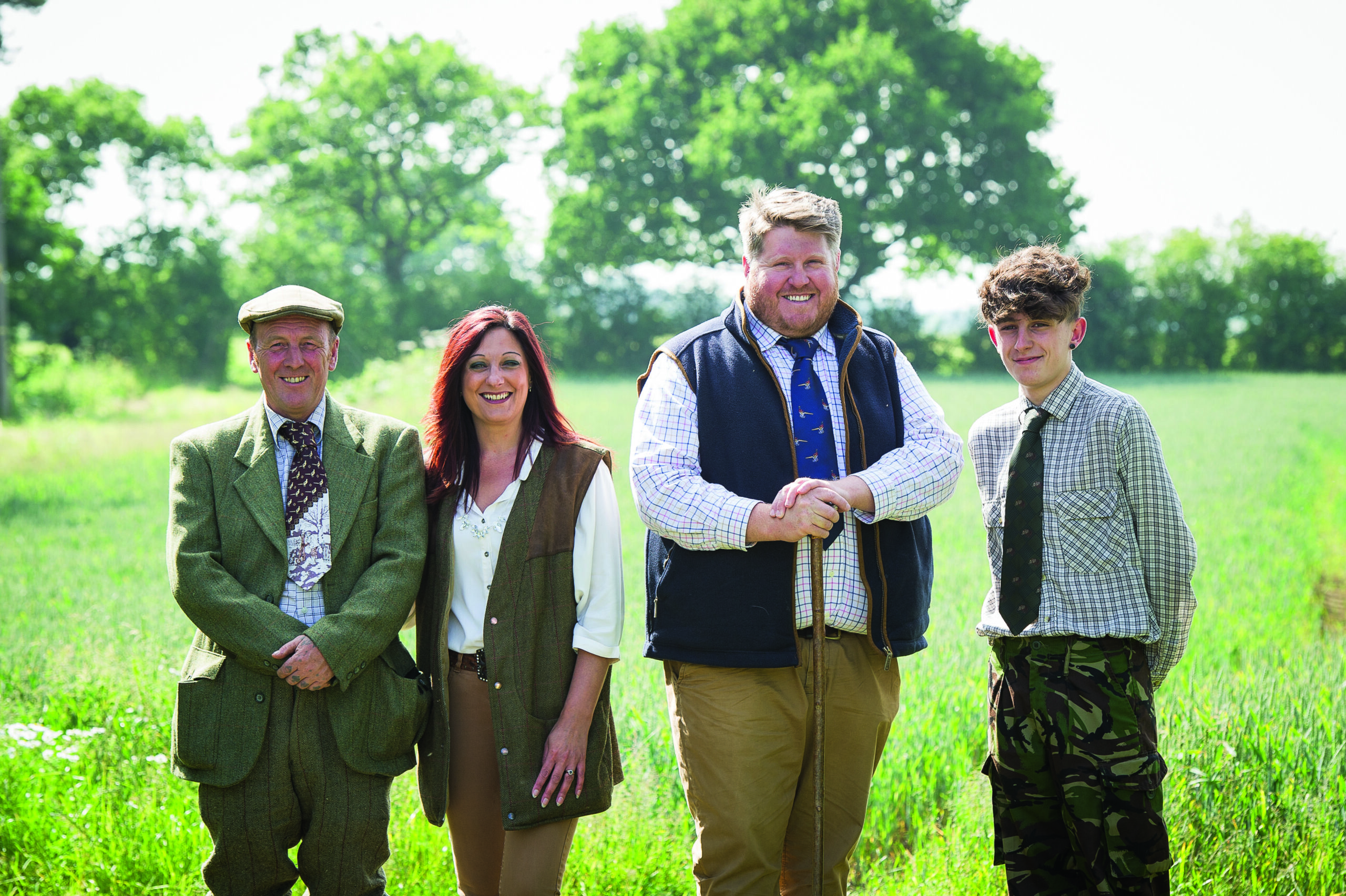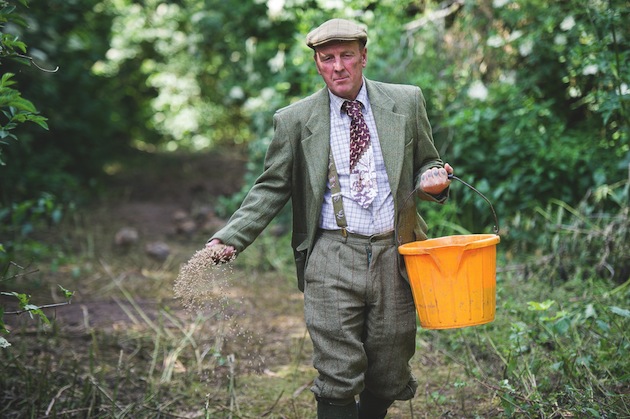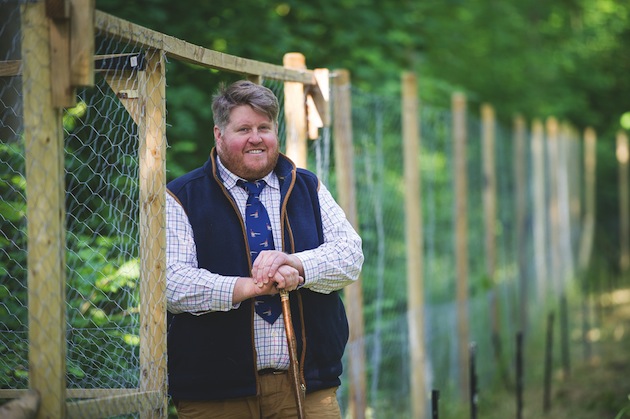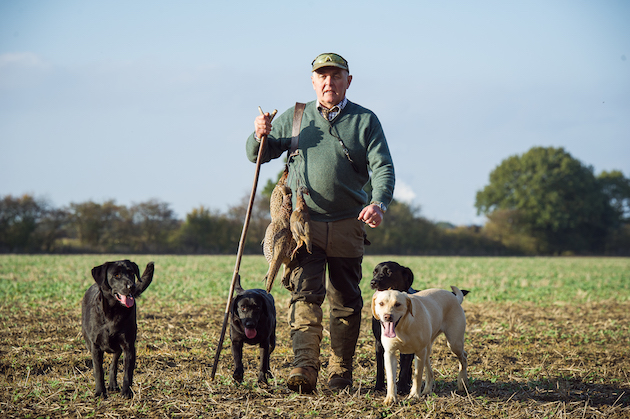Picking-up: Guns should be allowed to go picking-up on shoot day.
Win CENS ProFlex DX5 earplugs worth £1,149 – enter here
Ever thought of setting up your own shoot?
 Wayne Pryer (keeper), Cheryl Pryer, Jonathan Airey, Warren Pryer
Wayne Pryer (keeper), Cheryl Pryer, Jonathan Airey, Warren Pryer
I have often thought about running my own shoot. Many years ago I did, in fact, have a small shoot of my own where, with the help of a few friends and paying guests, we enjoyed some great days out in the field, even if the bag at times was barely enough to give us each something to take home. I realised after a few seasons that the effort involved left little spare time for other things, so I let someone else take it on. This left me free to book days shooting as and when I pleased, without the stress.
Today this is how thousands of us get our sport. We follow up ads in the shooting press or let our fingers do the walking online – we just tap our requirements into any number of websites and all our dreams can be realised, depending on the depth of our pockets.
But what of those individuals who still dream of running their own shoot? Many do so successfully, from the huge commercial set-ups to the modest groups of friends or farmers who just want a couple of walk-round days per season. Not far from my home in Lincolnshire is a large farming enterprise, where the shoot has had a number of tenants during the past 20 or 30 years. Last season, the shoot collapsed, leaving the incumbent keeper out of a job. Upon hearing that a new tenant had taken it on, I decided to meet him to find out just what it is that makes someone want to put themselves through the trials and tribulations that go with running a fairly large shooting operation.
Setting off on a shooting journey
Jonathan Airey’s first step into the countryside was a work placement on a farm at the age of 15. This allowed him the opportunity to pursue vermin with a gun and set him on a shooting journey. He went on to study agriculture at Bishop Burton College in Yorkshire and joined his first walk-one, stand-one syndicate when he was 21. Soon after he left agriculture and joined the railways in purchasing and logistics management for engineering works, and more recently in contracts management and delivery. About five years ago, he started running a small, non-profit shoot near his home in Lincolnshire.
Now aged 36, this has fired his enthusiasm for something bigger.
Though he has no plans to give up the smaller shoot, this bigger enterprise has no doubt tested his resolve.

With 27 years’ experience and five years on the shoot, keeper Wayne Pryer is well-placed to take the shoot forward
I arranged to meet Jonathan and Wayne Pryer, his gamekeeper, who has stayed on as the incumbent in the house at the invitation of the estate, because they recognised his diligence and work ethic were definite assets to the estate. When Jonathan took over the shoot, he was able to call on the skills of the man on the ground with five seasons’ knowledge of the estate and the shooting. Together they set about rebuilding what has been recognised by many visiting Guns as a great shoot with a great future.
The first thing that struck me as I drove down the lane to the shoot lodge was the relatively modest size of the fields, with high hedges interspersed with trees, ideal for showing partridges over. As Jonathan took me on a tour of the estate, he explained how he came to be in this position. He said he had not been looking for a shoot when a friend rang to say the Eagle Hall Shoot was up for let. He dismissed it at first, but thought it would do no harm to get a few details.
Getting the funding together
He arranged a visit and soon after signed a five-year lease — but not before he had put together a firm business plan, including a solid budget and cashflow forecast, formed a limited company and employed an accountant. Then he was able to go to his bank and, through its Lincolnshire agricultural business manager, gain additional funding to get the shoot up and running.
This was in February, so there was no time to lose. The plan included four new release pens for pheasants, so 900 posts were ordered along with 5,000m of wire netting, 70 pop-hole grids, 70 drinkers, 1,400m of water pipe, 5km of electric fence wire and posts, quad bike, trailers, spinner, power tools and all the other bits and pieces that are needed in the building of a shoot. In addition, there were 40 acres of gamecover to be planted — on the day of my visit in mid-June, this was already up and looking good.
The pheasant pens were almost completed, with more than 800 posts having been knocked in by hand. This Herculean task has been accomplished by Wayne and just two part-time helpers.
Well equipped
Now 51 years old, Wayne has been a keeper all his life and has learned his trade at such prestigious shoots as Longleat and Leigh Manor in Shropshire. He was the first-ever person to complete an NVQ in gamekeeping at Kingston Maurwood College in Dorset after starting a youth training scheme in 1988. Now with 27 years’ experience and five years on the shoot, he is well equipped to take Eagle Hall into the 21st century. He is ably assisted by his wife of 21 years, Cheryl, whose lunches and afternoon baking have already made her something of a legend to those Guns in the know — I was treated to homemade Scotch eggs and an array of cakes. I also visited the estate owners and spoke to director Michael Chennell, who doesn’t shoot. I asked him why he felt that letting the shooting on the estate was good business.
He said that though none of the family shoots, this is a traditional Lincolnshire estate and shooting has always played a part. It is compatible with the biodiversity and conservation that is so important to the landscape, he added.
Furthermore, having a gamekeeper such as Wayne on hand hugely increases the security on the estate, particularly at night, he told me.
Jonathan’s plan is to put Eagle Hall Shoot up there with the best, shooting partridges over high hedges and pheasants from traditional woodland. With 3,800 acres and 30 drives to call on, I have no doubt he has all the ingredients needed for success. It is reasonably priced, so days are filling fast, but if you want to join in you still can.
Visit Eagle Hall Shoot for further details.
Related Articles
Get the latest news delivered direct to your door
Subscribe to Shooting Times & Country
Discover the ultimate companion for field sports enthusiasts with Shooting Times & Country Magazine, the UK’s leading weekly publication that has been at the forefront of shooting culture since 1882. Subscribers gain access to expert tips, comprehensive gear reviews, seasonal advice and a vibrant community of like-minded shooters.
Save on shop price when you subscribe with weekly issues featuring in-depth articles on gundog training, exclusive member offers and access to the digital back issue library. A Shooting Times & Country subscription is more than a magazine, don’t just read about the countryside; immerse yourself in its most authoritative and engaging publication.










